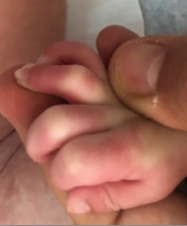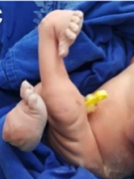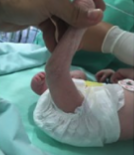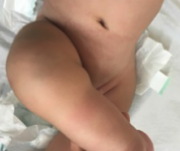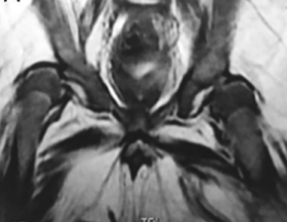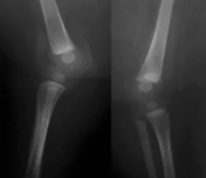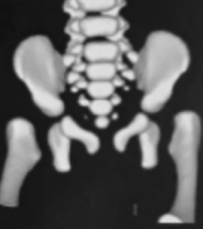Congenital Zika syndrome
| Congenital Zika syndrome | |
|---|---|
 | |
| Congenital Zika syndrome | |
| Specialty | Pediatrics |
| Symptoms | Small head, visual problems, contractures, stiffness[1] |
| Usual onset | Newborn baby[2] |
| Causes | Zika virus[2] |
| Risk factors | Zika virus infection in mother[2] |
| Diagnostic method | History, symptoms, blood/urine tests, medical imaging[2] |
| Differential diagnosis | Congenital toxoplasmosis, congenital syphilis, congenital varicella syndrome, parvovirus B19, congenital rubella, congenital cytomegalovirus infection, congenital herpes simplex, Aicardi-Goutières syndrome[2] |
| Prevention | Avoiding mosquito bites, mosquito control, birth control education[3] |
| Treatment | Supportive care[3] |
Congenital Zika syndrome presents as birth defects in a newborn baby of some mothers infected with Zika virus during pregnancy.[1] Symptoms typically include a small head, visual problems, contractures, and stiffness.[1] Less frequently heart problems, ambiguous genitalia, undescended testes, bowel problems, difficulty swallowing, hearing problems, or a small baby may occur.[2] Complications may include miscarriage or stillbirth.[2]
The cause is infection by the Zika virus, a type of flavivirus, during pregnancy.[2] Most infected mothers and their babies have no or mild symptoms.[4] Congenital Zika syndrome can occur regardless of whether the mother had symptoms.[3] Diagnosis is supported by detecting the virus in the mother, particularly if there are symptoms or a history of travel to an area with the Aedes mosquito.[3] Blood tests may confirm the diagnosis and distinguish Zika from Dengue.[3] Ultrasound may detect symptoms in the unborn baby.[2] MRI of the brain of the baby may show a collapsed skull and small brain.[2]
Treatment of Zika infection is supportive, with rest and hydration.[3] Prevention is by avoiding mosquito bites, mosquito control, and birth control education.[3]
Congenital Zika syndrome affects around 10% of babies born to mothers who had Zika infection during pregnancy.[3] The link between Zika and microcephaly was first documented in 2015 in Brazil.[2] The following year Zika was declared a Public Health Emergency of International Concern by the World Health Organization.[2] Limitations to diagnosis include the high cost of testing for Zika.[2] The Zika virus was first isolated in 1954 in Nigeria.[2]
Signs and symptoms
Symptoms typically include a small head, visual problems, contractures, and stiffness.[1] Less frequently heart problems, ambiguous genitalia, undescended testes, bowel problems, difficulty swallowing, hearing problems, or a small baby may occur.[2] Other abnormal nerve development consequences include, dystonia, tremors, mental disability, and hearing loss.[4]
In the eyes there may be scarring in the eyes and underdevelopment of the optic nerve.[4]
-
Finger deformities
-
Clubfeet
-
Knee dislocation
-
Knee contracture
-
Joint contractures
Diagnosis
Testing is recommended by the CDC for all babies born to mothers who test positive for Zika, and all babies with symptoms of Zika virus.[4] This is typically by RT-PCR and antibody testing on blood, and ZIKV RT-PCR on urine.[4]
-
MRI- bilateral dislocation of hips, epiphyseal core (small arrow), and dysplastic acetabulum (large arrow)
-
X-ray knees
-
CT hips
-
X-ray- dislocation of hips
See also
References
- ↑ 1.0 1.1 1.2 1.3 "Congenital Zika Syndrome & Other Birth Defects | CDC". Centers for Disease Control and Prevention. 22 April 2022. Archived from the original on 12 June 2023. Retrieved 8 September 2023.
- ↑ 2.00 2.01 2.02 2.03 2.04 2.05 2.06 2.07 2.08 2.09 2.10 2.11 2.12 2.13 2.14 Freitas, Danielle A.; Souza-Santos, Reinaldo; Carvalho, Liege M. A.; Barros, Wagner B.; Neves, Luiza M.; Brasil, Patrícia; Wakimoto, Mayumi D. (15 December 2020). "Congenital Zika syndrome: A systematic review". PLoS ONE. 15 (12): e0242367. doi:10.1371/journal.pone.0242367. ISSN 1932-6203. Archived from the original on 9 June 2022. Retrieved 9 September 2023.
- ↑ 3.0 3.1 3.2 3.3 3.4 3.5 3.6 3.7 "Zika virus". www.who.int. World Health Organization. Archived from the original on 26 January 2023. Retrieved 12 September 2023.
- ↑ 4.0 4.1 4.2 4.3 4.4 Hills, Susan L.; Woodworth, Kate R. (2022). "92. Zika virus disease and congenital Zika virus disease". In Jong, Elaine C.; Stevens, Dennis L. (eds.). Netter's Infectious Diseases (2nd ed.). Philadelphia: Elsevier. pp. 556–561. ISBN 978-0-323-71159-3. Archived from the original on 2023-09-13. Retrieved 2023-09-12.
